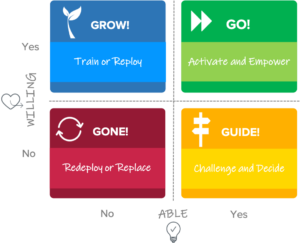Strategic Impatience: WAG Model for Talent Management

When the economy is doing well and unemployment is low, we hear about a “war for talent.” This paints a compelling picture where companies need to hold onto to their people or they will leave for better opportunities.
Despite record-low unemployment rates and the highest Quit Ratio (the % of people who quit a job vs. those that get fired/released) in 20 years, our clients are fighting a more complicated war for talent which has more battle lines and strategies beyond just holding onto the ones you have.
Strategic Impatience
New research indicates that people are not leaving ‘bad managers’ or ‘bad companies,’ they are leaving for greater opportunity. They see more growth potential outside the company than inside, especially as larger organizations are getting leaner and flatter.
This means the battlefront is less about retaining talent and more about making your team and organization a talent development machine – where the systems, processes, and culture favor opportunities and growth, even if the structure does not.
Most important in any change effort is a sense of urgency – a desire to move quickly and decisively to make things different. We need to get more urgent about growing and retaining our talent. And we need to get more impatient with talent that does not fit our needs (present or future).
The WAG Model
Your talent is not homogenous. Your approach shouldn’t be either. As people show up differently at work, you need to show up differently as a leader. Paraphrasing from John Kotter: management is standardized, equal, and fair across a team while leadership is personal, individual, and tailored to the needs of the individual and aligned to the organization.
Two dimensions of how your people show up are Willingness and Ability to GO. Willingness is attitude. It’s eagerness. It’s motivation. It is intrinsic. Ability is the capability to deliver. It includes the talent, the skills, and the knowledge to get the job done and done well. It is not complicated, but it is sophisticated.
Looking at Willingness and Ability gives you a simple, but powerful assessment to tailor your approach for how you lead your talent.

Able – To assess ability, list the top 5-10 key results, metrics, and activities the role is responsible for. Identify the key skills needed to achieve those top priorities. Then rate the individual leader or team on those skills. If they have all the skills they need, then they are able. If they are short in some key areas, then they are unable. Tactically speaking, the two key elements are quickly assessed. As a matter of fact, you probably already know where in the model each of your team members are.
Willing – To determine willingness, determine if the person is demonstrating the behaviors and attitudes needed by the team, culture, organization. If high performance is needed, do they deliver? If collaboration is needed, do they put up barriers to people from other departments? If their behaviors are aligned with the mission and values, then they are willing, if they are not, then they are unwilling.
Diving into each quadrant, here is a brief explanation and a set of tactics to maximize the outcome for you, your leaders, your team, and your organization:
Willing and Able – GO! (Activate and Empower)
- Definition: The best place for talent. They are capable. They have the skills needed. They demonstrate the attitudes, behaviors, and values that the culture and organization need. They are capable of at least Stage 3 (individual expertise) and hopefully Stage 4 (team/organization/tribe excellence).
- Tactics to Enable: Activate them. GO! Set them on their way with clear expectations of results and a clear vision of what success looks like. Get out of their way. Offer support.
- Don’t: Do not micromanage. Do not get between them and their people. Don’t second guess or etch-a-sketch their plans (i.e. after they’ve worked hard to create something, don’t shake it up to clear it off – like an etch-a-sketch – then design a different solution for them). That is undermining, and for someone who is willing and able, they are also able to leave you.
Willing, But Not Able – Grow (Train or Redeploy)
- Definition: This person or team does not have the requisite skills or experience needed to deliver on the results required, but they are willing to do what it takes to learn, to try, and to grow. How patient you can be depends on their individual trajectory (how fast they can acquire the skills and capabilities needed) and how much time you have for them to develop. In a steady-state market with low competition, you likely have more time for them to develop. In a turnaround environment, you have less time for skill development.
- Tactics: If there is a match between the time you have and the individual’s trajectory, then focus on development. Get them the training, information, mentorship, and experiences they need to be able. Be strategically patient with these people. Set clear expectations, establish benchmarks and development plan milestones, and follow-up frequently to offer additional support and development. If there is not the match between time and trajectory, then either redeploy that person to a role where they are able to deliver, or create a transition plan for a replacement (internal move or external hire).
Able, But Unwilling – Guide (Challenge and Decide)
- Definition: This person has the skills, but not the desire. This is an attitude gap and not a capability gap. Often we see this as someone who has “a high cost of accessing their brilliance.” They may be a technical expert, but the time, emotion, resources, etc. needed to access that brilliance is just not worth it.
- Tactics: The polite version is “guide.” Sit them down in a conversation and ask if they are willing to do what it takes to make a contribution and get the results needed and expected. If they say ‘no’ (explicitly or implicitly), then it’s pretty clear that it is time to separate them from the organization. If they say ‘yes’ then follow-up with accountability questions: What is the first sign that I will be able to see that you are demonstrating your ‘willing’ behavior? When will we be able to see that? What would you like me to do to help you if we don’t see that behavior by that time? Coaching can be helpful to a leader who is needs to work on their behavior and impact.
- Implicit ‘no’ – The implicit ‘no’ will show up in many different ways. One way is that they will say they are ‘in,’ and then quickly externalize the blame for why they have not done it yet. Another example is when they put someone else’s behavior as a dependency on their critical path. Example: I will do that just as soon as so-and-so in that-other-department does this-and-that. That deflection, abdication, and externalization shows a lack of ownership and is a sign they will continue to be unwilling. Again, be strategically impatient with these people. They will take more of your guidance and time to get things done.
Unwilling and Unable – Gone (Redeploy or Replace)
- Definition: This is easy. They don’t have the skills and they don’t have the interest in acquiring the skills. This is not a generational thing – older people are no more likely to be here than millennials or visa-versa. Often this is a feature of someone promoted or moved around an organization into roles they are not qualified for. Pure meritocracies tend to have few of these. Whereas relationship-based organizations, organizations that value loyalty over performance, tend to have more people in roles they are neither capable or willing to perform.
- Tactics: Confirm with them. Chances are they are aware that there is a mismatch. Determine if there are other roles that are available that they are more suited for, and would motivate them to perform better. If not, then simply separate them from the organization. They are, frankly, taking the time, resources, and budget away from someone else who would be willing and able to perform.
- Important Note: How you separate people from your organization matters. Defaulting to HR policy or legally protective statements is soul crushing for all sides. Create a different experience – cognizant of HR and Legal guidelines – but also cognizant that everyone is watching to see how (and if) we care about our employees. Respect, care, honesty, and support, are hallmarks. This is a colleague who deserves to be treated according to your values as they transition out and find “their next.” Offer to stay in contact and treat them as they would want to be treated if the roles were reversed.
Leadership has a responsibility to to be strategically patient with their talent when there is the time and space to grow talent internally. They also have the responsibility to separate those who are unwilling and/or unable to contribute in meaningful ways. Leadership is not only about setting the vision, direction, and expectations, it is about enforcing the minimum standards and raising those over time.
There is a war for talent. The big question is what are you doing with your talent to make sure you win the larger war?
